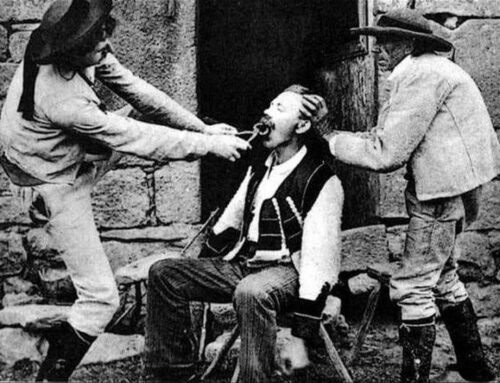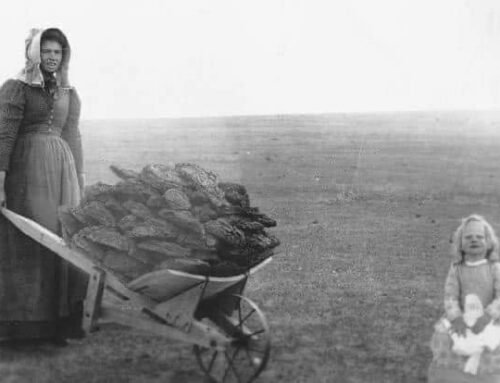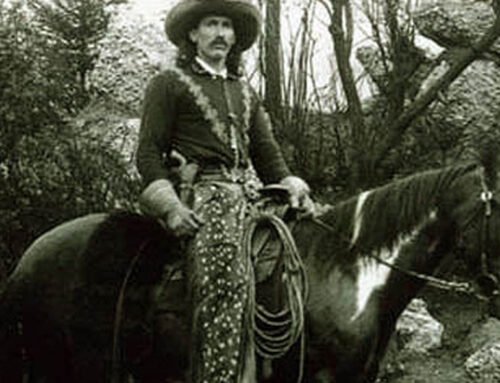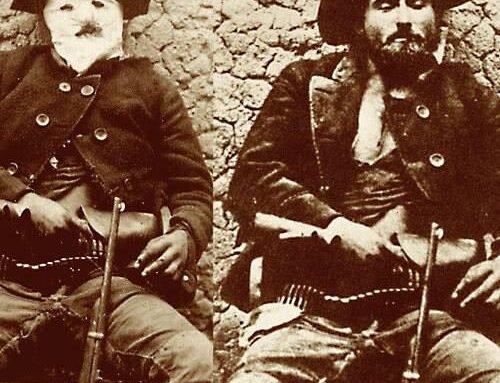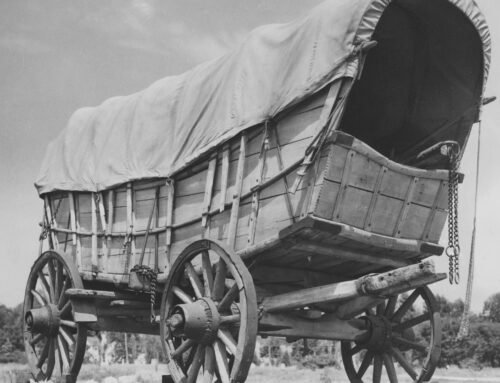Train-robber Tom ‘Blackjack’ Ketchum
By western author Nick Brumby
“Good-bye. Please dig my grave very deep. All right; hurry up.”
— The last words of train-robber Tom ‘Blackjack’ Ketchum, just before he was unintentionally decapitated when the hangman bungled his execution.
 Blackjack Ketchum started life as a Texas cowhand and ended up as one of the most notorious outlaws in Old West history, terrorizing Arizona, New Mexico, and West Texas along with his brother Sam.
Blackjack Ketchum started life as a Texas cowhand and ended up as one of the most notorious outlaws in Old West history, terrorizing Arizona, New Mexico, and West Texas along with his brother Sam.
But it wasn’t his crimes that gave him his place in history – it was his botched death sentence for train robbery, which saw his head torn off when the executioner miscalculated the drop on the gallows where Ketchum was hanged.
Born in Texas in 1863, Ketchum got the nickname ‘Blackjack’ when he was mistaken for Blackjack Christian, another outlaw. and the name stuck. He first fell afoul of the law 1880 when only 16 years old. Ketchum was summoned for contempt of court, arising from his failure to appear as a witness in an earlier case. His defiance of authority began before he even became of age.
In 1889, Tom Green County’s new sheriff, arrested Ketchum for pursuing a dog into a church and then down the aisle while a religious service was in progress. It was time for a new start.
 In 1890 he headed for New Mexico where he worked as a cowboy in the Pecos River Valley. Ketchum stood 5 foot 11, nearly 6 inches taller than the average male of that time, and, in prime condition, weighed 180 pounds. “Every inch seemed brawn and muscle,” noted one observer; another, years later, drew attention to his “wonderful physique.” He was dark skinned and black haired, with small, piercing eyes that were “indefinably swift and menacing” and “obsessed of an extraordinary alertness.”
In 1890 he headed for New Mexico where he worked as a cowboy in the Pecos River Valley. Ketchum stood 5 foot 11, nearly 6 inches taller than the average male of that time, and, in prime condition, weighed 180 pounds. “Every inch seemed brawn and muscle,” noted one observer; another, years later, drew attention to his “wonderful physique.” He was dark skinned and black haired, with small, piercing eyes that were “indefinably swift and menacing” and “obsessed of an extraordinary alertness.”
In 1892, Ketchum, his brother Sam, and several other outlaws learned that an Atchison, Topeka & Santa Fe Railroad train was enroute to Deming, New Mexico with a large payroll. The gang held the train up at gunpoint just outside Nutt, New Mexico, and made off with about $20,000.
In 1895, Ketchum and several other men shot and killed John “Jap” Powers, a neighbor in Tom Green County, Texas. After this murder, the Ketchum brothers headed back to New Mexico Territory.

Ketchum’s gang continued robbing trains in New Mexico, between Folsom and Des Moines in New Mexico, near the point where the old wagon road crossed the Colorado and Southern Rail tracks near Twin Mountain.
Ketchum joined the Hole in the Wall Gang and was involved in other robberies, netting hundreds of thousands of dollars in cash, gold and silver, and killing several posse members chasing them down. When not on the outlaw trail, he worked for ranches in New Mexico.
However, Ketchum’s luck finally ran out. After his brother was killed trying to rob a train in 1899, Ketchum decided to single-handedly hold up the same train. However, he was shot by the conductor wielding a shotgun, almost severing his arm. Ketchum later said, “I tried a dozen times to mount my horse but was too weak to do it.”
Weary and dizzy from the pain, he sat down to wait for the posse. He was taken to Trinidad, Colorado where his arm was amputated. Upon recovery, he was sent to Clayton, New Mexico to be tried for felonious assault upon a railway train. He was found guilty and sentenced to death by hanging.
 The hanging was scheduled for April 26, 1901, at 8:00am. The hanging was a big attraction in Clayton, with stores closing and saloons remaining open, doing a brisk business. People came from all over the area to see the big event, where the local lawmen were selling tickets to view the hanging, as well as little dolls of Tom hanging on a stick.
The hanging was scheduled for April 26, 1901, at 8:00am. The hanging was a big attraction in Clayton, with stores closing and saloons remaining open, doing a brisk business. People came from all over the area to see the big event, where the local lawmen were selling tickets to view the hanging, as well as little dolls of Tom hanging on a stick.
However, the town had no experience in hanging a man. and there was a debate concerning the length of rope. According to reports, it was decided that a drop of 5 feet 9 inches would suit a man of Ketchum’s weight (193 pounds). But someone made a mistake. The drop was lengthened further to 7 feet. This was a catastrophic error – even 5 feet 9 was already too long. And a Clayton newspaperman later wrote that local lawman Sheriff Garcia doctored the rope with soap “to make sure that it slipped properly.”
After a delay if some hours, and while they were adjusting the hood, Ketchum stated, “Hurry up boys, get this over with.” His last words were reported by the San Francisco Chronicle as: “Good-bye. Please dig my grave very deep. All right; hurry up.”
Finally, Sheriff Garcia took two blows with a hatchet, cut the rope and the condemned man fell through the trap. Since the drop was far too long a drop, and the lubricated rope was too thin and cordlike, Ketchum was immediately beheaded by the noose.

The black hood pinned to his shirt was the only thing that kept his head from rolling away. A few minutes later the doctor pronounced him dead, and his body was presented for viewing post-mortem, a standard practice at the time for executed criminals. The doctor then sewed his head to his torso prior to the burial at the Clayton’s Boot Hill at 2:30pm.
“Nothing out of the ordinary happened,” Sheriff Garcia declared. “No bungling whatever. Everything worked nicely and in perfect order.”. It was a bad way to die, but Ketchum, manifestly, had been a bad man.
Such was the spectacle of the scene that postcards were made of the gruesome event (see the attached pictures)
Blackjack Ketchum was the only person ever hanged in Union County, New Mexico. He was also the only person who suffered capital punishment for the offense of “felonious assault upon a railway train” in the State of New Mexico. Later, the law was found to be unconstitutional.
Records from the time state that he was the only criminal decapitated during a judicial hanging in the United States. The only other recorded example was in England in 1601. Later, the same thing occurred at the hanging of one Eva Dugan at the Pinal County, Arizona prison in 1930.
In the 1930’s his body was moved to the new cemetery in Clayton, where it remains today.

About Nick Brumby
I like a good story. And of all stories, I love westerns the most.
As a kid, I spent far too many afternoons re-watching Clint Eastwood spaghetti westerns, picking up ‘Shane’ for just one more read, or saddling up beside Ben Cartwright when ‘Bonanza’ was on TV each afternoon.
I’m a former journalist and I love horses, dogs, and the occasional bourbon whiskey. I live with my wife, daughter and our ever-slumbering hound in a 1800’s-era gold mining town – our house is right on top of the last working gold mine in the area. There may not be much gold left, but there’s history wherever you look.
I hope you enjoy my westerns as much as I enjoyed writing them!
Happy trails,
Nick






















